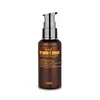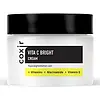What's inside
What's inside
 Key Ingredients
Key Ingredients

 Benefits
Benefits

 Concerns
Concerns

No concerns
 Ingredients Side-by-side
Ingredients Side-by-side

Sodium Hyaluronate
HumectantAscorbic Acid 5%
Antioxidant1,2-Hexanediol
Skin ConditioningNiacinamide
SmoothingArginine
MaskingNelumbo Nucifera Flower Extract
Skin ConditioningMagnolia Liliflora Bud Extract
Skin ConditioningLilium Tigrinum Extract
Skin ConditioningPaeonia Lactiflora Root Extract
Skin ConditioningTuber Magnatum Extract
Skin ConditioningPyrus Malus Fruit Extract
Skin ConditioningPanax Ginseng Root Extract
EmollientBrassica Oleracea Italica Extract
AstringentAnanas Sativus Fruit Extract
Skin ConditioningCurcuma Longa Root Extract
MaskingSodium Polyacrylate
AbsorbentAdenosine
Skin ConditioningDisodium EDTA
Sodium Hyaluronate, Ascorbic Acid 5%, 1,2-Hexanediol, Niacinamide, Arginine, Nelumbo Nucifera Flower Extract, Magnolia Liliflora Bud Extract, Lilium Tigrinum Extract, Paeonia Lactiflora Root Extract, Tuber Magnatum Extract, Pyrus Malus Fruit Extract, Panax Ginseng Root Extract, Brassica Oleracea Italica Extract, Ananas Sativus Fruit Extract, Curcuma Longa Root Extract, Sodium Polyacrylate, Adenosine, Disodium EDTA
Water
Skin ConditioningButylene Glycol
HumectantIsononyl Isononanoate
EmollientGlycerin
HumectantNiacinamide
SmoothingSaccharide Isomerate
HumectantSodium Polyacrylate
AbsorbentHydrogenated Polydecene
EmollientTrideceth-6
EmulsifyingButyrospermum Parkii Butter
Skin ConditioningSilica
AbrasiveTitanium Dioxide
Cosmetic ColorantSorbitan Stearate
EmulsifyingOrbignya Oleifera Seed Oil
EmollientPEG-40 Stearate
EmulsifyingArachidyl Alcohol
EmollientBehenyl Alcohol
EmollientArachidyl Glucoside
EmulsifyingDipotassium Glycyrrhizate
HumectantCetearyl Alcohol
EmollientTriethanolamine
BufferingCarbomer
Emulsion StabilisingXanthan Gum
EmulsifyingCitric Acid
BufferingBeeswax
Emulsion StabilisingDiisostearyl Malate
EmollientDimethicone
EmollientSqualane
EmollientLonicera Japonica Flower Extract
Skin ConditioningSolanum Lycopersicum Fruit Extract
AntioxidantLilium Tigrinum Extract
Skin ConditioningNelumbo Nucifera Seed Extract
AntimicrobialChrysanthemum Indicum Flower Extract
Skin ConditioningMyrciaria Dubia Fruit Extract
Skin ConditioningEuterpe Oleracea Fruit Extract
Panax Ginseng Root Extract
EmollientAloe Barbadensis Leaf Extract
EmollientCamellia Sinensis Leaf Extract
AntimicrobialHoney
HumectantRosa Multiflora Fruit Extract
MaskingGardenia Florida Fruit Extract
Skin ConditioningScutellaria Baicalensis Root Extract
AstringentLigustrum Japonicum Fruit Extract
Skin ConditioningCentella Asiatica Extract
CleansingSodium Citrate
BufferingDisodium EDTA
Phaseolus Radiatus Seed Extract
Skin ConditioningThymus Vulgaris Extract
PerfumingBuddleja Davidii Extract
Skin ConditioningTocopheryl Acetate
AntioxidantAscorbic Acid
AntioxidantPhenoxyethanol
PreservativeEthylhexylglycerin
Skin ConditioningParfum
MaskingWater, Butylene Glycol, Isononyl Isononanoate, Glycerin, Niacinamide, Saccharide Isomerate, Sodium Polyacrylate, Hydrogenated Polydecene, Trideceth-6, Butyrospermum Parkii Butter, Silica, Titanium Dioxide, Sorbitan Stearate, Orbignya Oleifera Seed Oil, PEG-40 Stearate, Arachidyl Alcohol, Behenyl Alcohol, Arachidyl Glucoside, Dipotassium Glycyrrhizate, Cetearyl Alcohol, Triethanolamine, Carbomer, Xanthan Gum, Citric Acid, Beeswax, Diisostearyl Malate, Dimethicone, Squalane, Lonicera Japonica Flower Extract, Solanum Lycopersicum Fruit Extract, Lilium Tigrinum Extract, Nelumbo Nucifera Seed Extract, Chrysanthemum Indicum Flower Extract, Myrciaria Dubia Fruit Extract, Euterpe Oleracea Fruit Extract, Panax Ginseng Root Extract, Aloe Barbadensis Leaf Extract, Camellia Sinensis Leaf Extract, Honey, Rosa Multiflora Fruit Extract, Gardenia Florida Fruit Extract, Scutellaria Baicalensis Root Extract, Ligustrum Japonicum Fruit Extract, Centella Asiatica Extract, Sodium Citrate, Disodium EDTA, Phaseolus Radiatus Seed Extract, Thymus Vulgaris Extract, Buddleja Davidii Extract, Tocopheryl Acetate, Ascorbic Acid, Phenoxyethanol, Ethylhexylglycerin, Parfum
 Reviews
Reviews

Alternatives
Ingredients Explained
These ingredients are found in both products.
Ingredients higher up in an ingredient list are typically present in a larger amount.
Ascorbic Acid is is pure Vitamin C. This form makes up the largest amount of vitamin C found naturally in our skin.
Not only is vitamin C great for your overall health and immune system, it also has plenty of benefits on your skin.
Vitamin C is best used for brightening skin. It improves dark spots, acne scars, and hyperpigmentation. This is because it blocks the process of skin darkening when exposed to UV.
Remember: Vitamin C should not replace sunscreen!
Your skin uses vitamin C to build collagen. Collagen is one key component in having a strong skin barrier and plump skin. Vitamin C also plays a role in regulating collagen, thus making it effective in improving wrinkles and fine lines.
Ascorbic acid shows potent antioxidant activity. As an antioxidant, it helps fight free-radicals. Free-radicals are molecules that may damage your skin cells. These antioxidants also protect skin against UV damage.
The best formulations include Vitamin E and/or ferulic acid. These two ingredients help stabilize and provide a boost in the benefits of ascorbic acid. This is because ascorbic acid becomes unstable when exposed to UV and air. In fact, you can tell your ascorbic acid has oxidized when it turns an orange-yellow color.
Ascorbic acid is generally compatible with other ingredients. However, using ascorbic acid with other active ingredients might cause irritation. Two ingredients: copper ions and benzoyl peroxide, will inactivate ascorbic acid completely.
Read more about other types of Vitamin C:
Foods rich with vitamin C include oranges, strawberries, broccoli, bell peppers, and more. When consuming Vitamin C, your skin receives a portion of the nutrients.
Learn more about Ascorbic AcidDisodium EDTA plays a role in making products more stable by aiding other preservatives.
It is a chelating agent, meaning it neutralizes metal ions that may be found in a product.
Disodium EDTA is a salt of edetic acid and is found to be safe in cosmetic ingredients.
Learn more about Disodium EDTALilium Tigrinum Extract comes from the Lily flower native to east Asia. It is more commonly known as "Tiger Lily".
Tiger Lily contains carotenoids, an antioxidant. Carotenoids give plants a distinct orange/yellow/red colors.
Studies show Tiger Lily has anti-inflammation properties.
Learn more about Lilium Tigrinum ExtractNiacinamide is a multitasking form of vitamin B3 that strengthens the skin barrier, reduces pores and dark spots, regulates oil, and improves signs of aging.
And the best part? It's gentle and well-tolerated by most skin types, including sensitive and reactive skin.
You might have heard of "niacin flush", or the reddening of skin that causes itchiness. Niacinamide has not been found to cause this.
In very rare cases, some individuals may not be able to tolerate niacinamide at all or experience an allergic reaction to it.
If you are experiencing flaking, irritation, and dryness with this ingredient, be sure to double check all your products as this ingredient can be found in all categories of skincare.
When incorporating niacinamide into your routine, look out for concentration amounts. Typically, 5% niacinamide provides benefits such as fading dark spots. However, if you have sensitive skin, it is better to begin with a smaller concentration.
When you apply niacinamide to your skin, your body converts it into nicotinamide adenine dinucleotide (NAD). NAD is an essential coenzyme that is already found in your cells as "fuel" and powers countless biological processes.
In your skin, NAD helps repair cell damage, produce new healthy cells, support collagen production, strengthen the skin barrier, and fight environmental stressors (like UV and pollution).
Our natural NAD levels start to decline with age, leading to slower skin repair, visible aging, and a weaker skin barrier. By providing your skin niacinamide, you're recharging your skin's NAD levels. This leads to stronger, healthier, and younger looking skin.
Another name for vitamin B3 is nicotinamide. This vitamin is water-soluble and our bodies don't store it. We obtain Vitamin B3 from either food or skincare. Meat, fish, wheat, yeast, and leafy greens contain vitamin B3.
The type of niacinamide used in skincare is synthetically created.
Learn more about NiacinamideGinseng root is a well-loved ingredient in Asian skincare for good reason. It hydrates the skin, soothes irritation, and helps even out skin tone.
In traditional East Asian medicine, ginseng has been used for centuries both as food and as a healing remedy, and modern research continues to confirm its skin benefits.
One of the standout features of ginseng is its ability to improve blood circulation and oxygen delivery to the skin, bringing a fresh supply of nutrients to support overall skin health. It also has antioxidant and anti-inflammatory properties. This helps to protect your skin against damage from UV exposure, pollution, and daily stress.
Additionally, studies suggest that ginseng may help reduce hyperpigmentation by inhibiting tyrosinase, the enzyme involved in melanin production.
There are different types of ginseng used in skincare, and while they all share core benefits, their potency can vary.
Most products use fresh or white ginseng because it’s more affordable. However, red ginseng, produced by steaming the root, contains higher levels of ginsenosides, which are compounds with proven anti-aging effects. These ginsenosides help reduce the appearance of wrinkles and improve skin elasticity.
Note: All forms of ginseng are listed simply as “Panax ginseng” in ingredient lists. We recommend reaching out to the brand if you have questions about which type of ginseng is used in their ingredients.
For general antioxidant benefits, any ginseng extract will do, but for wrinkle care or firmer skin, red or fermented ginseng is often more effective.
In short, ginseng is a powerhouse ingredient that supports hydration, radiance, and resilience.
Learn more about Panax Ginseng Root ExtractSodium Polyacrylate is the sodium salt of polyacrylic acid. It is used as an absorber, emollient, and stabilizer.
This ingredient is a super-absorbent polymer - meaning it can absorb 100 to 1000 times its mass in water. As an emollient, Sodium Polyacrylate helps soften and soothe skin. Emollients work by creating a barrier to trap moisture in. This helps keep your skin hydrated.